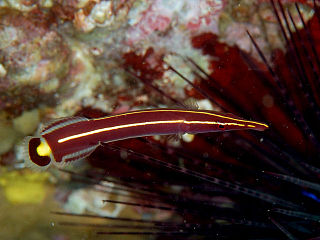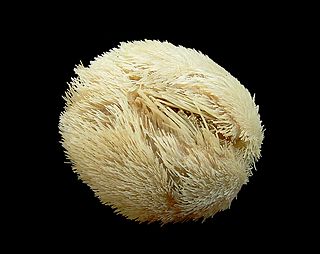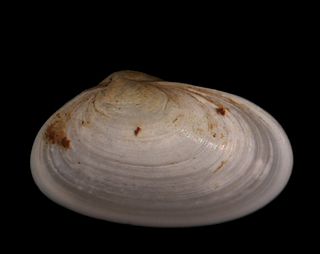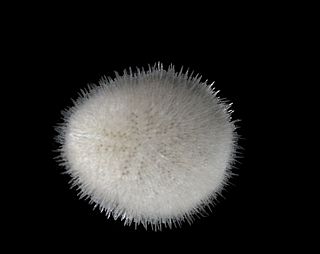
An echinoderm is any member of the phylum Echinodermata of marine animals. The adults are recognizable by their radial symmetry, and include starfish, sea urchins, sand dollars, and sea cucumbers, as well as the sea lilies or "stone lilies". Adult echinoderms are found on the sea bed at every ocean depth, from the intertidal zone to the abyssal zone. The phylum contains about 7000 living species, making it the second-largest grouping of deuterostomes, after the chordates. Echinoderms are the largest phylum that has no freshwater or terrestrial members.

Bivalvia, in previous centuries referred to as the Lamellibranchiata and Pelecypoda, is a class of marine and freshwater molluscs that have laterally compressed bodies enclosed by a shell consisting of two hinged parts. Bivalves as a group have no head and they lack some usual molluscan organs like the radula and the odontophore. They include the clams, oysters, cockles, mussels, scallops, and numerous other families that live in saltwater, as well as a number of families that live in freshwater. The majority are filter feeders. The gills have evolved into ctenidia, specialised organs for feeding and breathing. Most bivalves bury themselves in sediment where they are relatively safe from predation. Others lie on the sea floor or attach themselves to rocks or other hard surfaces. Some bivalves, such as the scallops and file shells, can swim. The shipworms bore into wood, clay, or stone and live inside these substances.

The diadema urchin or blue-black urchin is a species of tropical sea urchin, member of the Diadematidae family.

Meoma ventricosa, known by the common names cake urchin and red heart urchin, is a large species of sea urchin which lives in shallow waters in the Caribbean. It may reach a diameter of twenty centimeters and is covered in reddish-brown spines. It has both pentagonal radial symmetry and bilateral symmetry, giving it a sand-dollar appearance; however, two of its five sections are merged more closely than the others.

Lasaeidae is a family of very small saltwater clams, marine bivalve molluscs in the order Galeommatida. These bivalves are sometimes called "kelly clams", because one of the genera in this family is Kellia.

Diademichthys lineatus, commonly known as the long-snout clingfish or urchin clingfish, is a species of marine fish in the family Gobiesocidae.

Spatangus is a genus of heart urchins in the Spatangidae family. The genus is synonymous with the previously recognised genera Prospatangus Lambert, 1902 and Spatagus. There are nine recognised species. The type species is Spatangus purpureus Müller, 1776 by subsequent designation.

Echinometra mathaei, the burrowing urchin, is a species of sea urchin in the family Echinometridae. It occurs in shallow waters in the Indo-Pacific region. The type locality is Mauritius.

Echinocardium cordatum, also known as the common heart urchin or the sea potato, is a sea urchin in the family Loveniidae. It is found in sub-tidal regions in the NE Atlantic. Other un-named species have been identified as this species from temperate seas around the world. It lives buried in the sandy sea floor.

Tellimya ferruginosa is a species of small marine bivalve mollusc in the family Lasaeidae. It is found on the eastern side of the Atlantic Ocean.

Spatangus purpureus, commonly known as the purple heart urchin, is a species of sea urchin in the family Spatangidae. It is found in the eastern Atlantic Ocean and the Mediterranean Sea, where it lives immersed in the sediment.

Asthenosoma varium is a sea urchin. Growing up to 25 cm (10 in) in diameter, it lives on sand and rubble sea bottoms in the Indo-Pacific, from the Red Sea to Australia and Southern Japan. Its venom tipped spines, with distinctive globular swellings below the tip, can inflict a painful sting if handled; the pain lasts as long as several hours. This capacity, perhaps coupled with its reddish-brown colour, has given it the common name fire urchin; other commonly used names are Pacific fire urchin, elusive sea urchin, variable fire urchin, and electric sea urchin.
Listriolobus pelodes is a species of marine spoon worm. It is found in shallow seas in the North East Pacific off the coast of California. It lives in a burrow in soft sediments.

Cerianthus membranaceus, the cylinder anemone or coloured tube anemone, is a species of large, tube-dwelling anemone in the family Cerianthidae. It is native to the Mediterranean Sea and adjoining parts of the northeastern Atlantic Ocean.
Urticinopsis antarctica is a species of sea anemone in the family Actiniidae. It is found in the Southern Ocean around Antarctica.
Acrocnida brachiata, the sand burrowing brittlestar, is a species of brittle star in the family Amphiuridae. It occurs on the seabed in the northeastern Atlantic Ocean and the North Sea, living semi-buried in the sand with only its arm tips projecting.
Polydora glycymerica is a species of annelid worm in the family Spionidae, native to the northwestern Pacific Ocean, where it lives commensally in association with a bivalve mollusc, usually Glycymeris yessoensis but occasionally with another species of clam. The worm intercepts food particles being drawn into the mollusc by its feeding current.

Glycymeris yessoensis is a species of bivalve mollusc in the family Glycymerididae. It can be found burrowing in soft sediment in shallow water in the Pacific Ocean around the coasts of China and Japan. It is often associated with a polychaete worm with which it forms a commensal relationship.

Pourtalesia miranda, commonly known as the wonderful sea urchin, is a species of sea urchin in the family Pourtalesiidae. It is found at abyssal depths in the Atlantic Ocean.

Echinocyamus pusillus, commonly known as the pea urchin or green urchin, is a species of sand dollar, a sea urchin in the family Fibulariidae, native to the northeastern Atlantic Ocean and the Mediterranean Sea. It buries itself in gravel or coarse sand at depths down to about 1,250 m (4,000 ft).















